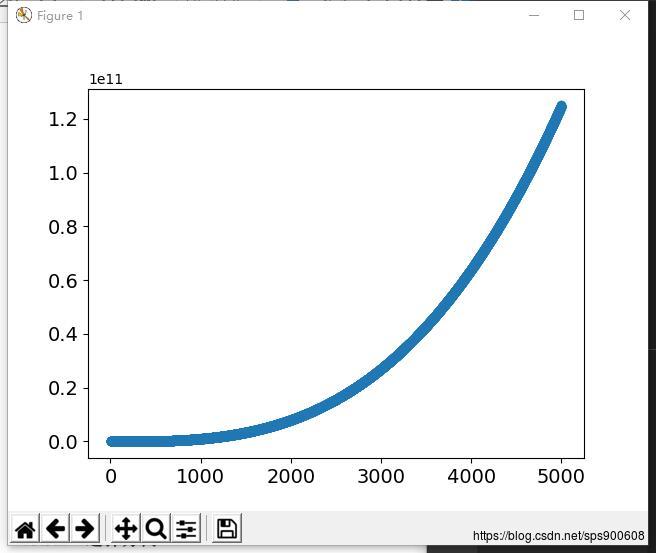Python3 学习笔记生成数据
Posted 究极死胖兽
tags:
篇首语:本文由小常识网(cha138.com)小编为大家整理,主要介绍了Python3 学习笔记生成数据相关的知识,希望对你有一定的参考价值。
Python3 学习笔记(十二)生成数据
参考书籍《Python编程:从入门到实践》【美】Eric Matthes
数字的三次方被称为其立方。请绘制一个图形,显示前5000个整数的立方值
import matplotlib.pyplot as plt
x_values = list(range(1, 5001))
y_values = [value**3 for value in x_values]
plt.scatter(x_values, y_values)
plt.tick_params(axis='both', labelsize=14)
plt.show()
给你前面绘制的立方图指定颜色映射。
import matplotlib.pyplot as plt
x_values = list(range(1, 5001))
y_values = [value**3 for value in x_values]
plt.scatter(x_values, y_values, c='red')
plt.tick_params(axis='both', labelsize=14)
plt.show()
模拟随机漫步
#random_walk.py
from random import choice
class RandomWalk():
def __init__(self, num_points=5000):
self.num_points = num_points
self.x_values = [0]
self.y_values = [0]
def fill_walk(self):
while len(self.x_values) < self.num_points:
x_direction = choice([1, -1])
x_distance = choice([0, 1, 2, 3, 4])
x_step = x_direction * x_distance
y_direction = choice([1, -1])
y_distance = choice([0, 1, 2, 3, 4])
y_step = y_direction * y_distance
if x_step == 0 and y_step == 0:
continue
next_x = self.x_values[-1] + x_step
next_y = self.y_values[-1] + y_step
self.x_values.append(next_x)
self.y_values.append(next_y)#rw_visual.py
import matplotlib.pyplot as plt
from random_walk import RandomWalk
while True:
rw = RandomWalk(5000)
rw.fill_walk()
plt.figure(figsize=(10, 6))
point_numbers = list(range(rw.num_points))
plt.scatter(rw.x_values, rw.y_values, c=point_numbers, cmap=plt.cm.Blues, edgecolors='none', s=1)
plt.scatter(0, 0, c='green', edgecolors='none', s=100)
plt.scatter(rw.x_values[-1], rw.y_values[-1], c='red', edgecolors='none', s=100)
plt.axes().get_xaxis().set_visible(False)
plt.axes().get_yaxis().set_visible(False)
plt.show()
keep_running = input('Make another walk? (y/n): ')
if keep_running == 'n':
break
修改rw_visual.py,将其中的plt.scatter() 替换为plt.plot() 。为模拟花粉在水滴表面的运动路径,向plt.plot() 传递rw.x_values和rw.y_values ,并指定实参值linewidth 。使用5000个点而不是50 000个点。
#rw_visual.py
import matplotlib.pyplot as plt
from random_walk import RandomWalk
while True:
rw = RandomWalk()
rw.fill_walk()
plt.figure(figsize=(10, 6))
point_numbers = list(range(rw.num_points))
plt.plot(rw.x_values, rw.y_values, linewidth=1)
plt.scatter(0, 0, c='green', edgecolors='none', s=100)
plt.scatter(rw.x_values[-1], rw.y_values[-1], c='red', edgecolors='none', s=100)
plt.axes().get_xaxis().set_visible(False)
plt.axes().get_yaxis().set_visible(False)
plt.show()
keep_running = input('Make another walk? (y/n): ')
if keep_running == 'n':
break
方法fill_walk() 很长。请新建一个名为get_step() 的方法,用于确定每次漫步的距离和方向,并计算这次漫步将如何移动。然后,在fill_walk() 中调用get_step() 两次:
#random_walk.py
from random import choice
class RandomWalk():
def __init__(self, num_points=5000):
self.num_points = num_points
self.x_values = [0]
self.y_values = [0]
def fill_walk(self):
while len(self.x_values) < self.num_points:
x_step = self.get_step()
y_step = self.get_step()
if x_step == 0 and y_step == 0:
continue
next_x = self.x_values[-1] + x_step
next_y = self.y_values[-1] + y_step
self.x_values.append(next_x)
self.y_values.append(next_y)
def get_step(self):
direction = choice([1, -1])
distance = choice([0, 1, 2, 3, 4])
step = direction * distance
return step模拟掷骰子
#die.py
from random import randint
class Die():
def __init__(self, num_sides=6):
self.num_sides = num_sides
def roll(self):
return randint(1, self.num_sides)#dice_visual.py
import pygal
from die import Die
die_1 = Die()
die_2 = Die(10)
results = []
for roll_num in range(50000):
result = die_1.roll() + die_2.roll()
results.append(result)
frequencies = []
max_result = die_1.num_sides + die_2.num_sides
for value in range(2, max_result + 1):
frequency = results.count(value)
frequencies.append(frequency)
hist = pygal.Bar()
hist.title = "Results of rolling a D6 and a D10 50000 times."
hist.x_labels = ['2', '3', '4', '5', '6', '7', '8', '9', '10', '11', '12', '13', '14', '15', '16']
hist.x_title = "Result"
hist.y_title = "Frequency of Result"
hist.add('D6 + D10', frequencies)
hist.render_to_file('die_visual.svg')
请修改die.py和dice_visual.py,将用来设置hist.x_labels 值的列表替换为一个自动生成这种列表的循环。如果你熟悉列表解析,可尝试将die_visual.py和dice_visual.py中的其他for 循环也替换为列表解析。
#dice_visual.py
import pygal
from die import Die
die_1 = Die()
die_2 = Die(10)
results = [die_1.roll() + die_2.roll() for roll_num in range(50000)]
max_result = die_1.num_sides + die_2.num_sides
frequencies = [results.count(value) for value in range(2, max_result + 1)]
hist = pygal.Bar()
hist.title = "Results of rolling a D6 and a D10 50000 times."
hist.x_labels = list(range(2, max_result + 1))
hist.x_title = "Result"
hist.y_title = "Frequency of Result"
hist.add('D6 + D10', frequencies)
hist.render_to_file('die_visual.svg')以上是关于Python3 学习笔记生成数据的主要内容,如果未能解决你的问题,请参考以下文章